
James Van Der Zee, Garveyite Family unit, Harlem, 1924, printed 1974, gelatin silver print, Corcoran Drove (Souvenir of Eric R. Fox), 2015.19.4388
How do visual artists of the Harlem Renaissance explore black identity and political empowerment?
How does visual fine art of the Harlem Renaissance relate to current-mean solar day events and bug?
How do migration and displacement influence cultural production?
"I believe that the [African American's] advantages and opportunities are greater in Harlem than in any other place in the state, and that Harlem will get the intellectual, the cultural and the financial eye for Negroes of the Us and will exert a vital influence upon all Negro peoples." —James Weldon Johnson, "Harlem: The Civilisation Capital letter," 1925
The Harlem Renaissance was a flow of rich cross-disciplinary artistic and cultural action amid African Americans between the end of World War I (1917) and the onset of the Great Depression and lead up to Earth War II (the 1930s). Artists associated with the motility asserted pride in black life and identity, a rise consciousness of inequality and bigotry, and interest in the rapidly changing mod world—many experiencing a freedom of expression through the arts for the first time.
While the Harlem Renaissance may be all-time known for its literary and performing arts—pioneering figures such every bit Langston Hughes, Zora Neale Hurston, Knuckles Ellington, and Ma Rainey may be familiar—sculptors, painters, and printmakers were primal contributors to the kickoff modern Afrocentric cultural move and formed a blackness avant-garde in the visual arts.
Aaron Douglas (1899–1979) is known equally the "father of African American art." He defined a mod visual linguistic communication that represented black Americans in a new low-cal. Douglas began his artistic career as a landscape painter but was influenced by mod art movements such equally cubism, in which subjects appear fragmented and fractured, and by the graphic arts, which typically use assuming colors and stylized forms. He and other artists also looked toward West Africa for inspiration, making personal connections to the stylized masks and sculpture from Republic of benin, Congo, and Senegal, which they viewed every bit a link to their African heritage. They too turned to the art of antiquity, such as Egyptian sculptural reliefs, of popular interest due to the 1922 discovery of Rex Tutankhamen'south tomb. Printmakers James Lesesne Wells (1902–1993) and Hale Woodruff (1900–1980) as well explored a streamlined approach that drew from African and European artistic influences.
Sculptor Richmond Barthé (1901–1989) worked in a realistic mode, representing his subjects in a nuanced and sympathetic light in which black Americans had seldom been depicted before. Painter Archibald John Motley Jr. (1891–1981) began his career during the 1920s every bit one of the first African American graduates of the School of the Art Institute of Chicago. In the early part of his career, he created intimate and direct portraits, such as Portrait of My Grandmother of 1922.
James Van Der Zee (1886–1983), a photographer, became the unofficial chronicler of African American life in Harlem. Whether through formal, posed family unit photographs in his studio or through photograph essays of Harlem's cabarets, restaurants, barbershops, and church services, his large body of piece of work documents a growing, diverse, and thriving community.
The germination of new African American creative communities was engendered in office past the Bully Migration—the largest resettlement of Americans in the history of the continental Usa, mainly from rural Southern regions to more populous urban centers in the Due north. Pursuit of jobs, amend teaching, and housing—as well as escape from Jim Crow laws and a life constrained by institutionalized racism—drove black Americans to relocate.
The onset of the Great Depression in 1929 deflated the creative energy of the flow every bit many people became unemployed and focused on coming together basic needs. All the same the Harlem Renaissance planted artistic seeds that would germinate for decades. Many of the visual artists associated with the Harlem Renaissance came to participate in the Federal Art Project (1935–1943), an employment program for artists sponsored past President Franklin Delano Roosevelt's Works Progress Administration. Further, a fundamental legacy of the Harlem Renaissance was the creation of the Harlem Community Art Center (HCAC) in 1937, part of a cross-country network of arts centers. The HCAC offered hands-on art making led by professional artists and maintained a printmaking workshop. The HCAC was critical in providing blackness artists continued back up and training that helped sustain the adjacent generation of artists to emerge later the war. In subsequent decades, the Harlem Renaissance inspired new waves of artists and laid critical groundwork for the ceremonious rights movement and the Black Arts Motion.
As a concluding annotation, women artists were besides role of the Harlem Renaissance and participated especially every bit singers, actors, dancers, and writers. Less well-known are the women visual artists of the catamenia. Gaining admission to the visual arts scene was more hard than entry into the performing arts, as the practice of painting and sculpture in particular were not considered gender-appropriate or "feminine." Two sculptors, Meta Vaux Warrick Fuller (1877–1968) and Augusta Cruel (1892–1962), the latter an activist, creative person, and managing director of the HCAC, fabricated their mark during the period, but their work has been largely disregarded and is only coming into full cess by fine art historians today.

Harlem Renaissance James Weldon Johnson,God'southward Trombones: 7 Negro Sermons in Verse, 1927
Ii artists collaborated on this famous Harlem Renaissance–era book, which combines interpretations of biblical parables written in contemporary verse with bold illustrations that echo the power and symbolism of the words.
The author James Weldon Johnson, author, poet, essayist, and chronicler of Blackness Manhattan (the title of one of his books), commissioned Aaron Douglas to illustrate God's Trombones. The volume is organized into eight chapters: an explanatory preface by Johnson and introductory prayer followed past 7 sermon-poems entitled "The Creation," "The Prodigal Son," "Go Downward Death—A Funeral Sermon," "Noah Congenital the Ark," "The Crucifixion," "Allow My People Go," and "The Judgment Day." Each sermon adopts the vernacular of an African American preacher and is accompanied by dynamic, blackness-and-white illustrations that cast the stories in a gimmicky light and feature black protagonists. Douglas's painting style used bold coloration, but press processes of the 1920s fabricated color illustrations hard and costly, which is why the illustrations are monochrome with text showtime in a single colour.
Acquire more nigh this work here

Harlem Renaissance Aaron Douglas,The Judgment Day, 1939, oil on tempered hardboard, Patrons' Permanent Fund, The Avalon Fund, 2014.135.1
Years after the 1927 publication of God'due south Trombones: Vii Negro Sermons in Verse, Aaron Douglas painted new works of fine art based on his original illustrations for the volume. The artist'south use of complementary colors (purple and xanthous/green) combined with overlapping arcs, zigzagging shapes, and the silhouetted figures' extended limbs create an energized composition. The fundamental figure, who is outsize to show his importance (a device used in aboriginal Egyptian art, which was an influence on Douglas's style) represents Gabriel, an archangel appearing in the Old and New Testaments of the Bible who serves as God's messenger and whose name means "God is my strength." The other figures answer to Gabriel's phone call and the pulsating forms advise the trumpet's echoing sound. The verse that accompanied the illustration published in God's Trombones likens Gabriel to a blues trumpeter:
And Gabriel'south going to ask him: Lord,
How long must I blow information technology?
And God'southward a-going to tell him: Gabriel,
Blow it calm and easy.
And then putting one human foot on the mountain meridian,
And the other in the middle of the bounding main,
Gabriel's going to stand and blow his horn.
To wake the living nations.
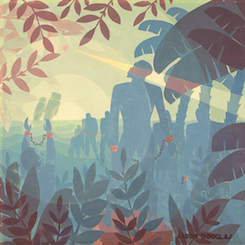
Harlem Renaissance Aaron Douglas,Into Chains, 1936, oil on canvas, Corcoran Drove (Museum Buy and fractional gift from Thurlow Evans Tibbs, Jr., The Evans-Tibbs Drove), 2014.79.17
This painting refers to the Atlantic slave trade, during which 10–12 1000000 people were trafficked from Africa to the Americas, most during the menses from the 1600s to the 1800s. The United states of america outlawed further slave trade into the country in 1808, although the practise itself was not abolished until 1864. The painting positions u.s. equally viewers backside a scrim of leafage, as if we are hiding or witnessing the scene. There is a receding line of male figures, heads bowed, advancing toward the sea and approaching ships that will forcibly transport them to a strange identify and life of enslavement. Aaron Douglas uses nonnaturalistic, complementary colors—teal-blue figures and a searing, lemon-yellow heaven—to add drama. Wrist shackles are painted a contrasting orange, which draws our center to them. One figure has dropped to his knees in the foreground, arms raised beseechingly heavenward, while a central standing figure gazes at a single star whose axle of light illuminates him, perchance a reminder that he is not forsaken.

Harlem Renaissance Fritz Winold Reiss,Untitled (Two Figures in an Incline), woodcut, Reba and Dave Williams Collection, Souvenir of Reba and Dave Williams, 2008.115.4080
Fritz Winold Reiss and his family emigrated from Federal republic of germany to the The states in 1913. He traveled extensively around the United states and United mexican states, and became interested in America'southward racial diversity, frequently portraying indigenous Americans and African Americans. Reiss illustrated The New Negro, Alain Locke's influential album of writing, thought, and verse that became an emblem of the Harlem Renaissance. Published in 1925, The New Negro asserted the unique qualities of black American culture and life and encouraged ownership and pride in its fine art and heritage.
Reiss, who was white, was inspired by the aforementioned sources as blackness artists and designers: mod European art and the stylized forms of African fine art, including ancient Egyptian art (run into the related Pinterest board for examples). Here, the figures, shown only in profile, are compressed into a geometrical space throbbing with agile lines and movement. 1 figure appears to tend the hair of another, while the multiply breasted effigy could be a goddess or symbol of fertility. Reiss'southward active limerick of jagged lines and radiating forms influenced Aaron Douglas.

Harlem Renaissance James Lesesne Wells,Looking Upward, 1928, woodcut in black on laid newspaper, Ruth and Jacob Kainen Collection, 1994.87.9
James Lesesne Wells institute inspiration in the stylized qualities of African sculpture and in German expressionist fine art, which revived the centuries-old medium of woodcut printing for the modern age. This piece of work shows an outsize, silhouetted figure making his way amid, and dominating, an urban forest of skyscrapers that seem to tumble in his wake. He appears to carry a minor model of other dwellings, perhaps a representation of habitation or the thought of dwelling house we retain in memory. The figure looks about him, as if seeking or aspiring to fit in or establish roots. Many African Americans elected to move from the S to Northern cities during the Neat Migration, experiencing both deportation and adjustment to new urban environments.

Harlem Renaissance Richmond Barthé,Head of a Boy, c. 1930, painted plaster, Corcoran Collection (The Evans-Tibbs Drove, Gift of Thurlow Evans Tibbs, Jr.), 2014.136.295
Richmond Barthé sculpted African American subjects in a sensitive, realist style. Barthé followed a classical manner in sculpture, assertive that whatever subject could be dignified and beautiful if rendered with skill and thoughtfulness. Upwardly until the Harlem Renaissance, African American faces rarely appeared as the fundamental subject of visual art. Barthé's art and interest in the male figure was informed by his identity as a gay homo, who according to the times was constrained in disclosing this part of his life openly, although he did detect fellowship and love interests amid the flow'south artists and intellectuals.
Barthé grew upwards in New Orleans and headed north with the support of his family to pursue an creative education at the Schoolhouse of the Fine art Constitute of Chicago (SAIC), where he studied painting. At the time, SAIC and the Pennsylvania University of the Fine Arts were the two US art schools that admitted African American students. Barthé discovered his talent for sculpture in 1927, when he was introduced to the medium during a grade assignment to create a portrait bust of a fellow student in clay (he completed two). These initial works were noticed by the instructor and included in an exhibition, The Negro in Fine art Week, launching Barthé's career and lifelong commitment to sculpture.

Harlem Renaissance Werner Drewes,Harlem Beauty, 1930, woodcut in black, Ailsa Mellon Bruce Fund, 1974.84.1
In 1930, Werner Drewes emigrated to New York Metropolis from Germany, where he had been an fine art student. This work is from the same year he arrived in New York and pays homage to African American womanhood and beauty. The image, created by a white artist who worked in circles outside of Harlem, attests to the widespread cultural impact of the Harlem Renaissance, of interest to people beyond racial and social lines, including artists, teachers, patrons, and funders who engaged in pluralist, interracial dialogues. Drewes occasionally made images of people and scenes in Harlem and other New York locations. Harlem Beauty has a timeless and sculptural quality, with its stripped-down focus on the adult female'south illuminated face in profile, a classical portrait manner. Drewes, like Fritz Winold Reiss, was associated with a modernist European tradition that too was of interest to many African American artists during the Harlem Renaissance. Tin can you lot recollect of other examples of cultural dialogue, wherein seemingly distinct populations influence each other'due south artistic practices?
Drewes worked in President Franklin Delano Roosevelt's Works Progress Administration (WPA) creative person employment programs as an art teacher at the Brooklyn Museum and Columbia University. He afterward headed the graphic arts division of the Federal Fine art Project, part of the WPA, in New York state. He was a prolific printmaker and, later on, painter.
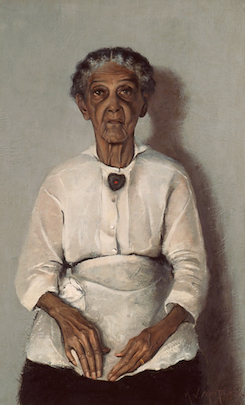
Harlem Renaissance Archibald John Motley Jr.,Portrait of My Grandmother, 1922, oil on canvas, Patrons' Permanent Fund, Avalon Fund, and Motley Fund, 2018.2.1
The extended Motley family moved from New Orleans to Chicago in 1894. The group included the creative person'due south paternal grandmother, Emily Motley, pictured here. Her son, Archibald Motley Sr., worked as a Pullman porter on the Michigan Central Railroad and his wife, Mary Fifty. Motley, was a schoolteacher. Their professions were among the highest-status and best-paying jobs black Americans could hold at the time and situated the family in the middle form. The family unit's move anticipated the northward Great Migration of African Americans that gained momentum during Earth War I and continued until the civil rights era.
The artist was among the get-go African Americans to nourish the School of the Art Institute of Chicago (from 1914 to 1918), where he also worked as a janitor to defray costs. Post-obit graduation, Motley elected to focus his art on themes around black American life. This portrait of his grandmother, who was born into slavery in Kentucky in 1842, is venerable and dignified, the effects of time and hard piece of work visible on her easily and face. She lived until historic period 87. The work, completed when Motley was still an unknown, may have been painted on a cast-off Key Railroad laundry purse from his male parent'due south train line.
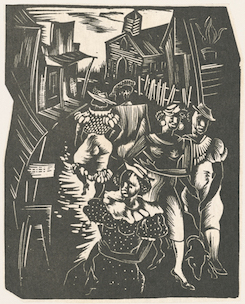
Harlem Renaissance Unhurt Woodruff, Robert Blackburn,Sunday Promenade, published 1996, linocut in blackness with chine-collé on wove newspaper, Corcoran Collection (Gift of E. Thomas Williams, Jr. and Auldlyn Higgins Williams in retention of Thurlow Evans Tibbs, Jr.), 2015.19.3032.8
Unhurt Woodruff, alongside Aaron Douglas, Richmond Barthé, and Archibald John Motley Jr., is amidst the major visual artists of the Harlem Renaissance. Robert Blackburn, an African American creative person also credited for this piece of work, founded the Printmaking Workshop in New York, where he taught lithography and printed editions for artists, such equally this 1. All of the same artists were built-in and lived outside New York, but ultimately relocated to Harlem, drawn past its magnetic art scene. In and then doing, they joined many African Americans in the northward exodus that became known as the Slap-up Migration. Woodruff studied art at Harvard University and at the School of the Art Institute of Chicago, as well as working in Paris, where he embraced modern styles of painting. In addition, he studied with Mexican muralist Diego Rivera, whom he admired for the social justice themes he pursued in his fine art.
Sun Promenade, office of a serial of work Woodruff made while living in Atlanta during the Depression, depicts two couples and a woman wearing their Lord's day best. A church building lies behind them in a point at the top of the limerick and underscores the axis of spiritual life in the African American community. The turned-out advent of the promenaders contrasts with the modest wooden structures also pictured. Woodruff also made politically charged work that dealt graphically with lynching, an upshot he felt compelled to face up with his art. During the beginning function of the 20th century, the NAACP and other groups worked to advance anti-lynching legislation, which was never passed.
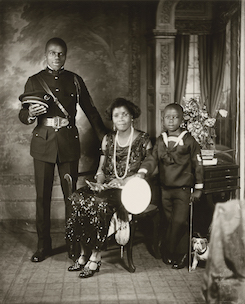
Harlem Renaissance James Van Der Zee,Garveyite Family unit, Harlem, 1924, gelatin silver print, printed 1974, Corcoran Collection (Gift of Eric R. Play a joke on), 2015.19.4388
James Van Der Zee opened the Guarantee Portrait Studio in Harlem in 1917. He captured the faces and lives of people who lived in Harlem: its famous entertainers, artists, leaders, and a growing black center form. He also took his photographic camera to the places they called their ain: homes, billiard halls, barbershops, churches, and clubs. Van Der Zee'southward work forms an important chronicle of black life of the period. This well-dressed family unit was associated with Marcus Garvey's movement, the Universal Negro Comeback Association (UNIA). UNIA advocated for black Americans (and others from the African diaspora) to emigrate to Africa to populate and farther develop Liberia, the merely non-colonial state on the continent. Van Der Zee was hired by the UNIA to record and document its marches, parades, and members, who adopted a quasi-militaristic advent. The UNIA became a mass motion of over 200,000 members during the 1920s, a time when the Ku Klux Klan had reemerged as a white nationalist grouping. Garvey was convicted of mail fraud in 1927 and deported to his native Jamaica. Absent-minded his leadership, the movement faded.

Harlem Renaissance James Van Der Zee,Alpha Phi Alpha Basketball game Team, 1926, gelatin silver impress, Corcoran Drove (The Evans-Tibbs Collection, Gift of Thurlow Evans Tibbs, Jr.), 2015.19.4507
This portrait of a college basketball team shows a serious group of young men united by their affiliation with their fraternity and its basketball team. Alpha Phi Alpha was the starting time intercollegiate African American fraternity in the United States, its first chapter founded in 1906 at Cornell University in Ithaca, New York. The fraternity provided support, written report groups, and, later, opportunities to participate in intercollegiate sports at a fourth dimension when black players were not permitted on college teams. Annotation how each thespian is advisedly posed and forms a symmetrical arrangement on the steps of the fraternity, showing their integrity as a grouping while radiating their decision to succeed in a racially divided country.

Harlem Renaissance Norman Lewis,Jazz, c. 1938, lithograph in blackness on wove newspaper, Reba and Dave Williams Drove, Florian Carr Fund and Souvenir of the Print Research Foundation, 2008.115.193
Like Aaron Douglas, Norman Lewis was attuned to the importance of jazz and blues music, peculiarly growing upward in Harlem during the heyday of the Harlem Renaissance. Only 19 when he created this print, the work shows a modern, abstract quality while capturing visually the sense of music produced by this quartet of musicians, who seem to bob in the space of the motion-picture show, emulating the rhythm of the music.
Lewis was influenced by the writings of Alain Locke, an intellectual, impresario, and leader of the Harlem Renaissance who advocated for black visual artists to explore the distinctive character of their feel and civilisation. Jazz is a hybrid fine art form with many influences, including West African music. In 1935, Lewis viewed African Negro Art, an early American exhibition (at the Museum of Modern Art, New York) of African sculpture, textiles, and objects shown as aesthetic works of art rather than ethnographic artifacts. Lewis then began a phase of drawing imagined African masks (come across the associated Pinterest board for an example). The masklike appearance of the figures in this work may besides have been influenced by the exhibition.
Lewis's printmaking activeness over the course of his career was express; he made prints for the Works Progress Administration'due south Federal Art Projection (FAP) during the Depression years and several editions independently in the 1940s, after which he returned to printmaking only sporadically. Later the 1940s, Lewis embraced brainchild in his art and became well-known in the 1950s and across for his large-scale paintings, 1 of which is as well in the National Gallery of Art collection (encounter the related Pinterest board). He is also notable among the artists who took part in the FAP—as printmakers, muralists, and teachers—who later became prominent abstract artists, including Jackson Pollock, Willem de Kooning, and Jacob Lawrence.

Harlem Renaissance Isac Friedlander,Rhapsody in Blackness, 1931, wood engraving, Reba and Dave Williams Collection, Souvenir of Reba and Dave Williams, 2008.115.1943
Isac Friedlander, a white printmaker who emigrated to the United States in 1929, reminds united states that the Harlem Renaissance and its exuberant nightlife was too an attraction for progressive-minded whites who traveled to Harlem to partake of the entertainment, which was generally entirely produced, written, and performed past blackness artists and impresarios. Here a top-hatted bandleader leads a grouping of robed singers, a jazz orchestra, and a pianist in a vibrant musical upshot. The technique of wood engraving that Friedlander used is a process in which the creative person uses negative, or white, lines to describe the image (think of drawing on a black scratchboard). The technique can produce nuanced detail due to the very fine-grained wood that is used for the process. The nature of the medium allowed Friedlander to capture the feeling of a nighttime nightclub with the performers' faces illuminated past stage lights. This dynamic scene may accept been captured by Friedlander prior to the onset of the Depression.

Harlem Renaissance Alfred Stieglitz,Brancusi Exhibition at 291, 1914, printed 1924/1937, gelatin silverish print, Alfred Stieglitz Collection, 1949.iii.353
This is an paradigm that documents a 1914 gallery exhibition of sculptures by Constantin Brancusi, a Romanian modernist who worked in Paris and was greatly influenced by the forms of African fine art. At this fourth dimension, W African fine art was being imported to the United states of america by French and Belgian art dealers. This fine art had come to the attention and involvement of artists working in Paris at the first of the 20th century, including Pablo Picasso, Henri Matisse, Paul Gauguin, Amedeo Modigliani, Brancusi, and others, who were searching for new forms to express the mod era and a new century. They establish inspiration in the frequently abstract and stylized forms of African art, too as the art of other non-Western cultures and of antiquity. The human relationship of Europeans to the fine art of Africa entails a complex dynamic that raises questions about who has the right to appropriate and interpret another civilisation's patrimony. A generation later on the Parisian modernists, the artists of the Harlem Renaissance too borrowed from the forms of African art as a means of reconnecting with and expressing pride in their African heritage.
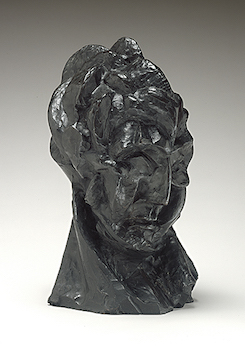
Harlem Renaissance Pablo Picasso,Caput of a Woman (Fernande), model 1909, cast before 1932, bronze, Patrons' Permanent Fund and Gift of Mitchell P. Rales, 2002.1.1
Many Europeans assimilated influences from African art, including Spanish artist Pablo Picasso, who often worked in Paris
At left, the modeled and cast head of Picasso's companion, Fernande Olivier, is in a cubist mode. Cubism shattered ideas of how space and objects could be depicted in art. For the first fourth dimension, art was not trying to reproduce the advent of a person or object. Instead, objects and the subjects of portraits, similar this one, were fractured into smaller planes and surfaces. Cubism was meant to portray the artist's way of seeing and perceiving the subject. Modern artist David Hockney has noted, "Cubism was an assail on the perspective that had been known and used for 500 years. It was the beginning big, big change. It confused people: they said, 'Things don't expect similar that!'" Some of Picasso'southward inspiration for cubism derived from his interest in African art, and particularly masks, which he collected and kept in his studio in Paris.

Harlem Renaissance Amedeo Modigliani,Head of a Adult female, 1910/1911, limestone, Chester Dale Drove, 1963.x.241
Amedeo Modigliani, an artist from Italy, also worked in Paris, a vibrant cultural capital that attracted immature artists from all over Europe. His work does non embrace cubism, but he bathetic the features of his Caput of a Woman by elongating them, perhaps in emulation of African masks or archaic sculpture. In turn, artists of later generations, such as those of the Harlem Renaissance, became interested in both the values of modern art, which rejected the art styles and traditions of the by, and in African art, which developed along a distinct trajectory independent of Europe.

Harlem Renaissance Walker Evans,Figure of a Woman, Laongo, 1935, gelatin silver impress, Gift of Samuel and Marilyn Stern, 1991.119.17
This work of art was among some 600 presented in a 1935 exhibition at the Museum of Modern Art, New York, entitled African Negro Fine art. The exhibition marked the offset time that not-Western cultural objects were shown in a mod fine art gallery as aesthetic art objects rather than ethnographic artifacts. In so doing, the museum best-selling the significant influence of African art, traded from colonized African countries, on Western modern art.

Harlem Renaissance Walker Evans,Polychrome Mask, 1935, gelatin silver print, Gift of Samuel and Marilyn Stern, 1991.119.6
In 1935, the Museum of Mod Fine art in New York presented the exhibition African Negro Art. The exhibition's accent on the objects' aesthetic qualities led the museum to omit information almost their cultural context and ceremonial use or significance, which prevented visitors from accessing a deeper agreement of the objects' origins. For example, the championship of this mask does not offer cultural data, such as the fact that it is from Gabonese republic or the Democracy of the Congo, Kwele people. What tin you discover near art from West Africa and its characteristics?
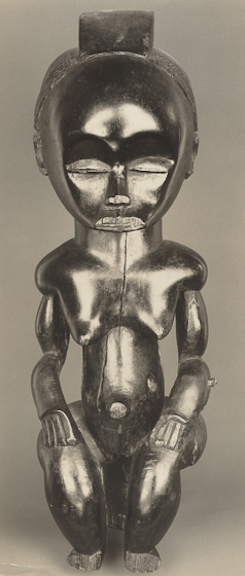
Harlem Renaissance Walker Evans,Figure of a Young Woman, Pahouin, Border of Spanish Guinea, 1935, gelatin silver print, Gift of Samuel and Marilyn Stern, 1991.119.10
Today, the Pahouin culture referred to in this object'due south title is more normally known equally Fang or Fãn, a Central African ethnic group.
The Museum of Modernistic Art's 1935 exhibition, African Negro Art, was photographed by Walker Evans, who may be best known for his photography documenting the effects of the Depression in rural America. Evans produced a portfolio containing 477 prints of African Negro Fine art; most of these sets were given to African American colleges and universities in the Us.




















